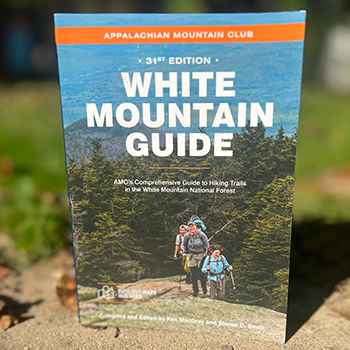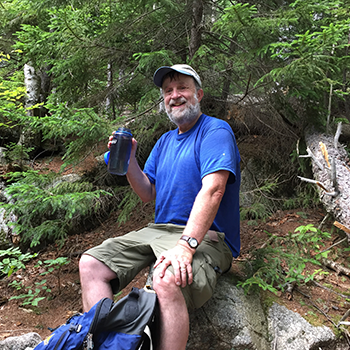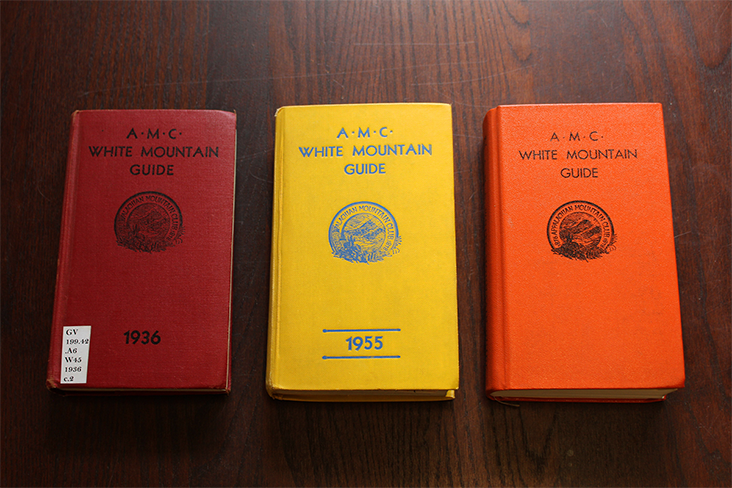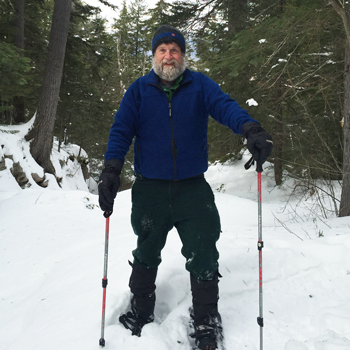On a sunny June afternoon in Lincoln, New Hampshire, Steven D. Smith is where he is most days when he’s not out hiking: in his bookstore, The Mountain Wanderer. He alternates between working at his computer on an upcoming guidebook he’s editing and helping customers find information on local hikes. Many of the visitors aren’t customers per se, but rather people just looking for advice or wanting to talk to him about hiking in the White Mountain National Forest.
One couple asks Smith to autograph the latest edition of the Appalachian Mountain Club (AMC) White Mountain Guide, which he has edited or co-edited for nearly 25 years. Another man comes in who says he’s hiked 47 of New Hampshire’s 48 mountains over 4,000 feet but is concerned about the last – a long hike to a peak called Owl’s Head with no official path. Smith patiently walks him through the hike, listing mileages and landmarks off the top of his head, and after a half-hour of looking at maps and hiking apps together, the man leaves obviously feeling better about the trip.
Originally from New Jersey, Smith was introduced to hiking as a Boy Scout, exploring the Catskill Mountains in southeastern New York. He first came to New Hampshire in the 1970s as a college student, but it wasn’t until he got a job working at the iconic Mount Washington Hotel, with its stunning views of the White Mountains’ Presidential Range, that he really got the hiking bug and made friends with some lifelong hiking buddies.
Smith relates that his initial excursions into the White Mountains weren’t particularly auspicious, having had to abort several planned trips after underestimating the steep and rugged terrain. It didn’t help that the calf-high boots he’d worn to protect himself from snake bites (only to find out that poisonous snakes in New Hampshire are extremely rare) weren’t exactly keeping him light on his feet.


The more Smith hiked, the more he relied on the AMC White Mountain Guide, which has been in print since 1907. “I first picked up the 1976 edition of the AMC guide, and I studied it intensely, plotting trips and taking in trail descriptions,” he says.
As Smith embarked on his own quest to summit all the 4,000 footers, finishing in 1981 on the often-dreaded Owl’s Head, he also learned to appreciate the subtle wording of the guidebook prose. He later met and hiked with AMC guide editor Gene Daniell, who’d added the geography pieces for the beginning of each regional section packed with what Smith describes as “mountain lore.” He appreciates the descriptive phrasing Daniell used, such as referring to mountain ridges as “Gothic masterpieces” with “towers supported by soaring buttresses.”
Smith first sent in comments and corrections for the 1992 edition of the guide, alongside his friend, hiking partner and eventual co-editor Mike Dickerman. They would go on to collaborate on several books, including The 4,000-Footers of the White Mountains: A Guide and History, first published in 2001 and with a third edition published in October 2023.
Dickerman relates that the first edition was about 360 pages, while the newest is over 700, and that it’s his job to rein in Smith. “Steve has just such a wealth of knowledge of these mountains that he wants to have everything he knows in there,” Dickerman jokes. “Nobody that I know of knows the mountains and the trails the way he does."
Both Smith and Dickerman emphasize that working on guidebooks is a very collaborative process with lots of input from others, in particular from previous editors. “We’re building on what so many other people did before us,” says Smith. “I always consider us to be caretakers of the book, going all the way back to the legendary people that did it back in the early 1900s.”

He relates that what’s particularly impressive is the fact that Daniell and other previous editors calculated all the trail distances for some earlier editions using metal measuring wheels. Anyone who has hiked some of the more challenging trails in the White Mountains – with their rock scrambles, ladders and stream crossings – will appreciate how much harder it would be pushing a cumbersome measuring wheel.
Smith has also developed a great network of people from other organizations who keep him apprised of changes to trails, and he gets a lot of good intel at his bookstore. “Any editor of a trail guide of this magnitude needs to be dialed in to the community and to all the outdoors organizations working in the area beyond simply the AMC,” explains the AMC’s senior book editor Tim Mudie. “Steve has those connections, and so he’s been able to really expand on the areas covered and make the book as comprehensive as possible.”
From his early days of exploring the White Mountains, Smith has gone on to hike all 1,400-something miles of trails in the AMC White Mountain Guide, a rare accomplishment known as “redlining.” For the past 20 years, he has relied on two successive Subaru Forester models to take him all over the state, counting on them to get to some of those remote trailheads often located on muddy, rocky and rutted roads.


He has written and edited various books, including the aptly named Wandering Through the White Mountains: A Hiker’s Perspective, a collection of articles and experiences gained from his decades of exploring the Whites. And over the years, Smith has developed his own writing style in the tradition of his guidebook predecessors, describing one ridge as “[d]ark, massive, and densely wooded, its northwest face raked with glistening slides,” and relating how a long bushwhack was “enlivened by extended tussles with dense scrub and vexing blowdown.”
Smith says that he always hopes that hikers who use the guidebooks will be inspired to become stewards of the mountains, whether through getting involved in trail maintenance or some other avenue. And he is quick to point out that he would not have been able to dedicate so much time to book writing and his store without the full support of his wife, Carol.
These days, Smith divides his time between the bookstore, going on long bushwhacks through the woods, and working on a long-standing project to write a book about New Hampshire’s “slides,” great slabs of bare rock resulting from landslides.
Of his time in the store, Smith quips that he gets to see a lot of repeat customers and talk about hiking every day, one of his favorite pastimes. As far as working on physical guidebooks in an age when so many rely on digital hiking apps, Smith thinks there will always be a place for the books. As he wrote for the centennial retrospective of the AMC guide, “There is something comforting about holding a still relatively small book in one’s hands, knowing that inside is the key to many happy days of adventure in the mountains, far away from our increasingly wired world.”





